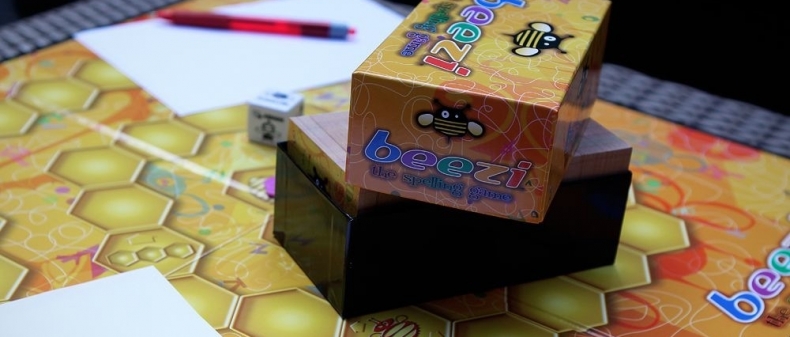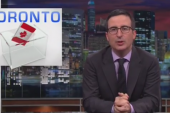
Tony Goldstein used to work in retail, running several souvenir stores. He was struck with an idea for a board game and decided to go for it. The result was the newly released Beezi, a spelling game. Toronto Standard asked Goldstein about what goes into the making of a board game, and how you can do it too.
Why a spelling game?
I read a lot, but I always have a dictionary close at hand because if I don’t know the word — which is often — I’ll find it difficult to continue reading with this niggling at the back of my head. So I’d be reading and I’d read things went terribly awry. And I’d think; “awry. I have no idea what that means.” So I’d look it up in the dictionary and read the definition and of course I knew awry. I’d slap myself upside the head because I’ve heard the word a million times and had never seen it in print. The next day I asked somebody, ‘do you know this word? How do you pronounce it?’ and people invariably would get it incorrect. They’d say, ask me another one. And I’d say, ‘Well how about segue?’ I’ve said that word also a million times. But the first time I saw it in print I read it as “se-goo-way”. And they’d say, ‘Ask me another one! Ask me another one!’ And I’d ask them to spell “feral”, because almost nobody spells feral correctly. It kind of graduated from there. People seem to be interested in and curious about spelling.
How did you come up with the concept?
Beezi’s name is based on Spelling Bees. I knew I wanted the game designed using the bee idea in the format of the beehives and the honey combs. All the little characters on the cards — I thought that looking ahead, one day I’d be able to create characters or collectibles of these bees. I thought it had a lot of potential. So I went to an artist-designer and I told him what I was looking to do, and he came up with the design. He designed the bee characters. For the words, my sister and I went through the dictionaries from ‘aardvark’ all the way to ‘zulu’, picking words that I then categorized into four levels of difficulty. The difficulty levels were a little arbitrary. We’d play the games based on the words we had categorized, played with other people, we find we’d have to change some of the words. Make them more difficult or less or get rid of them altogether. And eventually we got to the point where it is as you see it today.
How long did the whole process take?
I was working with the artist on a contingency basis and he fit me in when he had time in his schedule to do the art and design. It took a lot longer because of him. But I think I could have done the whole thing, just in terms of conceiving the idea and getting it on paper — well within a year. We put together a kid’s version that’s coming out and that didn’t take long. The boards and the cards and everything are the same, other than the words. So we had to go through the whole process again of putting together kids’ words from grade 3 to grade 7. That was a few months of work.
Why do you think that board games are experiencing a renewed interest now?
There seems to be everywhere — a sort of sprouting of board-game based cafes. I know there’s quite a few in Toronto, one of them opened just last week. I took them a couple of games in their cafe. If anything, it may just be a bit of a backlash against all the technology. There was a book written by Sherry Turkle called Alone Together: Why We Expect More From Technology & Less From Each Other. You see all these kids sitting at their computer consoles or on their phones — and they’re really all by themselves. They’re so interconnected with all the social media, with Facebook, whatever. They might have a thousand ‘friends’, but they’re really all by themselves. They’re all essentially alone – together. If one can sit across a table or across a board from others and interact that way, I just think that’s a nice change. It’s important. And hopefully it doesn’t get lost, and hopefully people realize that now. It’s a nice way for people to engage and interact and be social, as opposed to sitting on your telephone or computer.
What would you do differently?
I’d do lots differently. I thought I’d done all my due diligence and homework. I hadn’t. The first incarnation of the game is very different to what it is today. My game is made in China. And through a good friend I was connected to someone who I thought was in the industry but just happened to be an agent. And so when I met with them and talked to them about what it was I was looking to do, I just think they went to China and sourced manufacturers of a board, and of a dice, and paper manufacturers, and printers. They weren’t really in the industry itself. The second time I did it, I went down to New York to the New York Toy Fair. And I met a manufacturer that’s US-based that has facilities in China, and they facilitated the whole process for me. It might be a wee bit more expensive, but I’m working with people in the actual industry and they’ve been fantastic to work with, and the product turned out exactly as I’d hoped.
New York City’s Toy Fair is usually in February. There’s one in Toronto too, the Canadian Toy & Hobby Fair, but it’s tiny compared to the NY one. The NY one is probably the biggest in North America, so anyone wanting to get into the industry — I think that’s a worthwhile visit to make.
What’s the biggest challenge?
If you go in to any toy store, there’s tons and tons of board games on the shelf. There’s six of one, half a dozen of another. They all look the same. What I’m doing today — this in-store demo, if I can get people engaged for a couple of minutes, they really respond well. I think there’s going to be an even more positive response to the kids’ version when it comes in. It’s landing in Canada in the middle of July, I don’t know when it will make its way to the Chapters/Indigo chain but I’m hoping it will. All of these managers of the stores that I have been doing these in-store demos, they all really like what I’ve told them. With the art work I’ve shown them, they seem to think the kids’ version will do well. It was one thing to put the game together. It was somewhat challenging but I always knew, from the time I started, that at some point I’m going to have this finished product in my hand. Getting it from my hand to the consumer’s hand however, is way more daunting and challenging than having put this whole game together. It’s much more difficult because of the number of product already on the shelves. But if I get people just to play the game with me for a minute or two, they take really well to it.
What’s the best part?
Interacting with the customers. Because I created this — I shouldn’t take all the credit I did this with my sister — but I really like that people respond well to something that I’ve created that didn’t exist until I created it. To have people respond well to it, it’s a good feeling.
You can get your own Beezi here.
____
Tiffy Thompson is a writer and illustrator for the Toronto Standard. Follow her on Twitter at @tiffyjthompson.
For more, follow us on Twitter at @TorontoStandard and subscribe to our newsletter.














